-
 Bitcoin
Bitcoin $83,622.6306
-1.03% -
 Ethereum
Ethereum $1,589.6945
-1.99% -
 Tether USDt
Tether USDt $1.0000
0.01% -
 XRP
XRP $2.0889
-1.88% -
 BNB
BNB $580.0353
-0.85% -
 Solana
Solana $126.7178
-2.33% -
 USDC
USDC $1.0000
-0.01% -
 TRON
TRON $0.2506
-0.43% -
 Dogecoin
Dogecoin $0.1537
-3.31% -
 Cardano
Cardano $0.6091
-4.20% -
 UNUS SED LEO
UNUS SED LEO $9.3201
-0.87% -
 Chainlink
Chainlink $12.2503
-3.06% -
 Avalanche
Avalanche $19.0105
-5.53% -
 Stellar
Stellar $0.2359
-1.88% -
 Toncoin
Toncoin $2.8505
-1.13% -
 Shiba Inu
Shiba Inu $0.0...01170
-2.63% -
 Sui
Sui $2.0950
-4.30% -
 Hedera
Hedera $0.1569
-4.99% -
 Bitcoin Cash
Bitcoin Cash $319.8208
-1.32% -
 Litecoin
Litecoin $75.7238
-2.04% -
 Polkadot
Polkadot $3.5266
-3.99% -
 Dai
Dai $1.0001
0.01% -
 Bitget Token
Bitget Token $4.2562
-1.04% -
 Hyperliquid
Hyperliquid $15.1159
-4.03% -
 Ethena USDe
Ethena USDe $0.9992
0.01% -
 Pi
Pi $0.6455
-12.89% -
 Monero
Monero $215.1633
0.19% -
 Uniswap
Uniswap $5.1866
-3.08% -
 OKB
OKB $51.9360
-0.45% -
 Pepe
Pepe $0.0...06972
-4.89%
What is the difference between cloud mining and physical mining?
Cloud mining offers lower entry barriers and less technical complexity, while physical mining provides more control and potentially higher returns but requires significant investment and expertise.
Apr 16, 2025 at 01:49 am
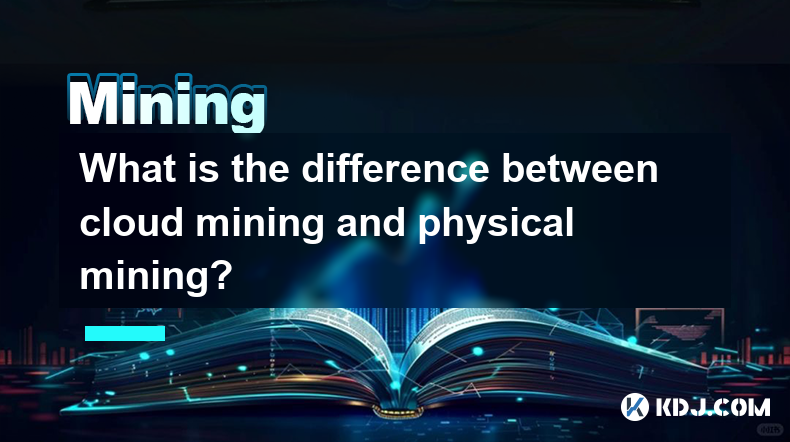
What is the difference between cloud mining and physical mining?
In the world of cryptocurrencies, mining is the process by which new coins are generated and transactions are verified and added to the blockchain. There are two primary methods of mining: cloud mining and physical mining. Understanding the differences between these two approaches can help you make an informed decision about which method suits your needs best.
Definition and Basics of Cloud Mining
Cloud mining is a method of mining cryptocurrencies without the need for owning and maintaining the hardware yourself. Instead, you rent mining power from a data center that operates and manages the mining equipment. This approach allows individuals to participate in the mining process without the technical knowledge or the financial investment required to set up and maintain their own mining rigs.
In cloud mining, you typically purchase a contract from a cloud mining provider. These contracts can vary in terms of duration, hash rate, and cost. Once you have purchased a contract, the provider allocates a portion of their mining power to you, and you receive a share of the rewards generated by the mining operation. The profits are then paid out to you in the cryptocurrency of your choice, usually after deducting the provider's fees.
Advantages of Cloud Mining
One of the primary advantages of cloud mining is the reduced entry barrier. It eliminates the need for significant upfront investment in hardware, which can be prohibitively expensive. Additionally, cloud mining providers handle all the technical aspects of mining, including maintenance, electricity costs, and cooling, which can be a significant relief for those who lack the technical expertise or resources to manage their own mining operation.
Another advantage is the flexibility that cloud mining offers. You can easily scale your mining power up or down by purchasing additional contracts or not renewing existing ones. This flexibility can be particularly beneficial in a volatile market where the profitability of mining can fluctuate significantly.
Disadvantages of Cloud Mining
However, cloud mining also has its drawbacks. One of the main concerns is the reliability of cloud mining providers. There have been numerous cases of fraudulent providers that either disappear with users' investments or fail to deliver the promised returns. It is crucial to thoroughly research and choose a reputable provider to mitigate this risk.
Another disadvantage is the lack of control over the mining process. When you use a cloud mining service, you have no say in the specifics of the operation, such as which cryptocurrencies are mined or how the mining power is utilized. This can be a significant drawback for those who want to have more control over their mining activities.
Definition and Basics of Physical Mining
Physical mining, on the other hand, involves setting up and operating your own mining equipment. This method requires a significant initial investment in hardware, such as ASICs (Application-Specific Integrated Circuits) or GPUs (Graphics Processing Units), depending on the cryptocurrency you intend to mine. You are also responsible for the ongoing costs of electricity, cooling, and maintenance.
In physical mining, you have complete control over your mining operation. You can choose which cryptocurrencies to mine, adjust your mining strategy based on market conditions, and optimize your setup for maximum efficiency. The rewards you earn from mining are directly deposited into your wallet, without any intermediaries.
Advantages of Physical Mining
One of the key advantages of physical mining is the level of control it offers. You can fine-tune your mining operation to maximize profitability, and you have the freedom to switch between different cryptocurrencies as market conditions change. This level of control can be particularly advantageous in a dynamic market environment.
Another advantage is the potential for higher returns. Since you are not paying a third party for mining services, you can keep a larger share of the mining rewards. Additionally, if you are able to secure electricity at a low cost, your profit margins can be significantly higher compared to cloud mining.
Disadvantages of Physical Mining
However, physical mining also comes with its own set of challenges. The initial investment required to set up a mining operation can be substantial. High-performance mining hardware can be expensive, and the cost of electricity can quickly add up, especially if you are mining in a region with high energy prices.
Another disadvantage is the technical complexity involved in setting up and maintaining a mining operation. You need to have a good understanding of the hardware and software involved, as well as the ability to troubleshoot any issues that may arise. This can be a significant barrier for those who lack the necessary technical skills.
Comparing Cloud Mining and Physical Mining
When comparing cloud mining and physical mining, it is important to consider your individual circumstances and goals. Cloud mining offers a lower entry barrier and less technical complexity, making it an attractive option for beginners or those who do not want to deal with the intricacies of managing their own mining operation. However, it comes with the risk of unreliable providers and less control over the mining process.
On the other hand, physical mining offers greater control and potentially higher returns, but it requires a significant upfront investment and technical expertise. It is best suited for those who are willing and able to manage their own mining operation and have the resources to do so effectively.
Frequently Asked Questions
Q1: Can I switch between cloud mining and physical mining?
Yes, it is possible to switch between cloud mining and physical mining. If you start with cloud mining and later decide to set up your own mining operation, you can do so by purchasing the necessary hardware and transitioning to physical mining. Conversely, if you are currently engaged in physical mining and want to try cloud mining, you can sell your hardware and purchase a cloud mining contract. However, keep in mind that switching methods may involve significant changes in your investment and operational strategy.
Q2: How do I choose a reliable cloud mining provider?
Choosing a reliable cloud mining provider is crucial to avoid scams and ensure you receive the promised returns. Here are some steps to help you make an informed decision:
- Research the provider's reputation: Look for reviews and testimonials from other users. Websites like Trustpilot and forums dedicated to cryptocurrency can provide valuable insights.
- Check the provider's history: A provider with a long history of operation is generally more trustworthy than a new entrant.
- Verify the provider's transparency: Reputable providers will be transparent about their operations, including the location of their data centers and the specifics of their mining hardware.
- Read the contract carefully: Understand the terms and conditions of the contract, including the duration, hash rate, and fees. Make sure there are no hidden clauses that could affect your returns.
- Start with a small investment: If you are unsure about a provider, start with a small investment to test their reliability before committing more funds.
Q3: What are the environmental impacts of physical mining?
Physical mining can have significant environmental impacts, primarily due to its high energy consumption. Mining operations, especially those using ASICs, require a lot of electricity, which can contribute to carbon emissions if the energy source is not renewable. Additionally, the heat generated by mining hardware requires cooling, which can further increase energy usage. Some miners have turned to renewable energy sources, such as solar or hydroelectric power, to mitigate these impacts, but the overall environmental footprint of physical mining remains a concern.
Q4: How do I calculate the profitability of a mining operation?
Calculating the profitability of a mining operation involves several factors:
- Hash rate: The speed at which your mining hardware can solve the cryptographic puzzles required to mine a block.
- Difficulty level: The difficulty of the mining algorithm, which adjusts based on the total network hash rate.
- Block reward: The amount of cryptocurrency awarded for successfully mining a block.
- Electricity cost: The cost of the electricity required to run your mining hardware.
- Hardware cost: The initial investment in mining hardware and any ongoing maintenance costs.
You can use online mining calculators to input these variables and estimate your potential profits. Keep in mind that profitability can fluctuate based on market conditions and changes in the mining difficulty, so it is important to regularly reassess your calculations.
Disclaimer:info@kdj.com
The information provided is not trading advice. kdj.com does not assume any responsibility for any investments made based on the information provided in this article. Cryptocurrencies are highly volatile and it is highly recommended that you invest with caution after thorough research!
If you believe that the content used on this website infringes your copyright, please contact us immediately (info@kdj.com) and we will delete it promptly.
- Public Companies Added Nearly 100,000 Bitcoin To Their Balance Sheets During Q1 2025
- 2025-04-16 07:15:16
- Amidst the Stormy Seas of the Crypto World, a New Titan Emerges—BlockDAG
- 2025-04-16 07:15:16
- Bitcoin (BTC) reclaims $85,000, setting the stage for altcoins to rally
- 2025-04-16 07:15:14
- The Pi Network token price has increased by more than 14% over the past week.
- 2025-04-16 07:15:14
- A wave of capital is flowing out of Ethereum [ETH] and into Tron [TRX]
- 2025-04-16 07:05:14
- Figment to power 3iQ's newly approved Solana exchange-traded fund (ETF)
- 2025-04-16 07:05:14
Related knowledge

What is the difference between cloud mining and physical mining?
Apr 16,2025 at 01:49am
What is the difference between cloud mining and physical mining? In the world of cryptocurrencies, mining is the process by which new coins are generated and transactions are verified and added to the blockchain. There are two primary methods of mining: cloud mining and physical mining. Understanding the differences between these two approaches can help...
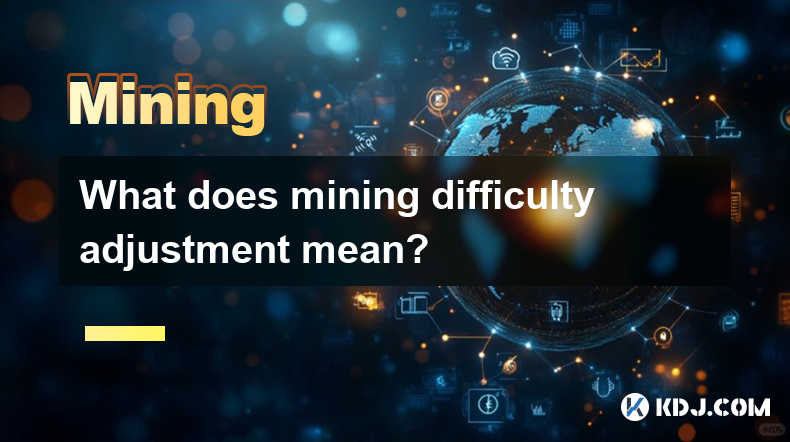
What does mining difficulty adjustment mean?
Apr 16,2025 at 12:42am
What does mining difficulty adjustment mean? Mining difficulty adjustment is a crucial mechanism in blockchain networks, particularly in Proof of Work (PoW) systems like Bitcoin. It ensures that the rate at which new blocks are added to the blockchain remains consistent, despite fluctuations in the total computational power (hash rate) of the network. T...
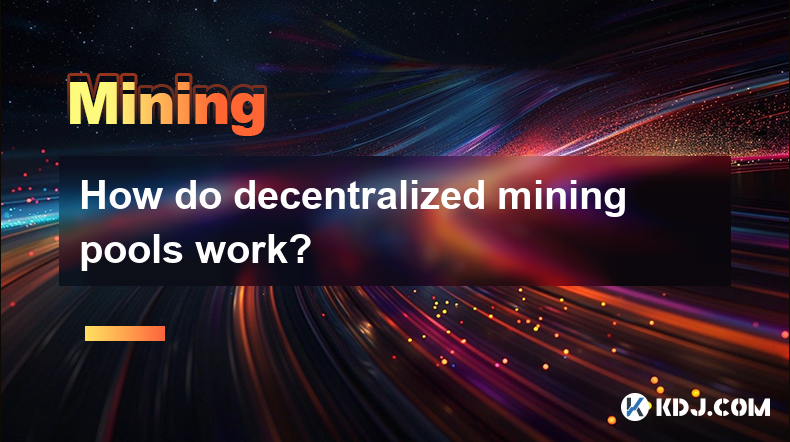
How do decentralized mining pools work?
Apr 16,2025 at 05:42am
Decentralized mining pools represent a significant evolution in the world of cryptocurrency mining, offering a more democratic and transparent approach compared to traditional centralized pools. In this article, we will explore the mechanics of decentralized mining pools, their benefits, and how they operate within the cryptocurrency ecosystem. What are...
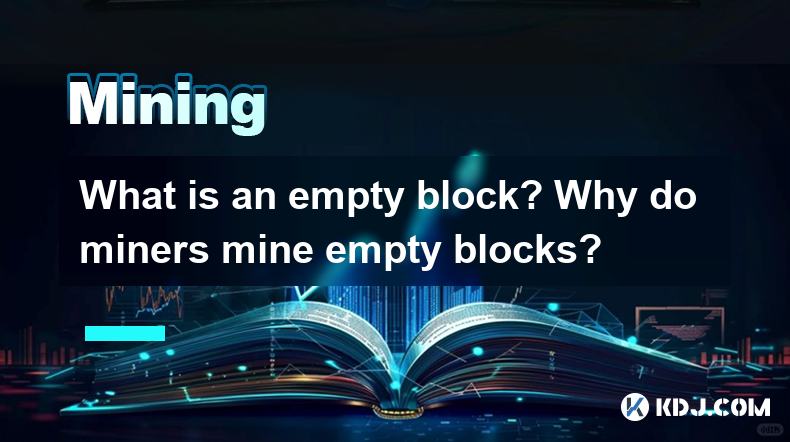
What is an empty block? Why do miners mine empty blocks?
Apr 16,2025 at 01:28am
What is an Empty Block?An empty block in the context of blockchain technology, particularly in cryptocurrencies like Bitcoin, refers to a block that contains no transactions other than the coinbase transaction. The coinbase transaction is a special transaction in which new bitcoins are generated and awarded to the miner who successfully mines the block....

What is the KawPow algorithm?
Apr 16,2025 at 06:43am
The KawPow algorithm is a proof-of-work (PoW) consensus mechanism specifically designed for the Ravencoin blockchain. It evolved from the earlier X16R and X16RV2 algorithms, aiming to enhance the security and efficiency of the mining process. KawPow was introduced to address the issues associated with ASIC (Application-Specific Integrated Circuit) miner...
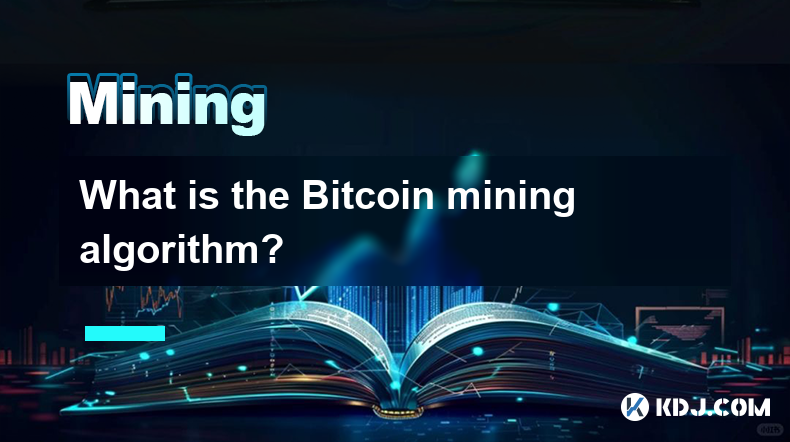
What is the Bitcoin mining algorithm?
Apr 15,2025 at 08:00pm
What is the Bitcoin Mining Algorithm? Bitcoin mining is a crucial process that maintains the integrity and security of the Bitcoin network. At the heart of this process lies the Bitcoin mining algorithm, which is responsible for verifying transactions and adding them to the blockchain. Understanding this algorithm is essential for anyone interested in t...

What is the difference between cloud mining and physical mining?
Apr 16,2025 at 01:49am
What is the difference between cloud mining and physical mining? In the world of cryptocurrencies, mining is the process by which new coins are generated and transactions are verified and added to the blockchain. There are two primary methods of mining: cloud mining and physical mining. Understanding the differences between these two approaches can help...

What does mining difficulty adjustment mean?
Apr 16,2025 at 12:42am
What does mining difficulty adjustment mean? Mining difficulty adjustment is a crucial mechanism in blockchain networks, particularly in Proof of Work (PoW) systems like Bitcoin. It ensures that the rate at which new blocks are added to the blockchain remains consistent, despite fluctuations in the total computational power (hash rate) of the network. T...

How do decentralized mining pools work?
Apr 16,2025 at 05:42am
Decentralized mining pools represent a significant evolution in the world of cryptocurrency mining, offering a more democratic and transparent approach compared to traditional centralized pools. In this article, we will explore the mechanics of decentralized mining pools, their benefits, and how they operate within the cryptocurrency ecosystem. What are...

What is an empty block? Why do miners mine empty blocks?
Apr 16,2025 at 01:28am
What is an Empty Block?An empty block in the context of blockchain technology, particularly in cryptocurrencies like Bitcoin, refers to a block that contains no transactions other than the coinbase transaction. The coinbase transaction is a special transaction in which new bitcoins are generated and awarded to the miner who successfully mines the block....

What is the KawPow algorithm?
Apr 16,2025 at 06:43am
The KawPow algorithm is a proof-of-work (PoW) consensus mechanism specifically designed for the Ravencoin blockchain. It evolved from the earlier X16R and X16RV2 algorithms, aiming to enhance the security and efficiency of the mining process. KawPow was introduced to address the issues associated with ASIC (Application-Specific Integrated Circuit) miner...

What is the Bitcoin mining algorithm?
Apr 15,2025 at 08:00pm
What is the Bitcoin Mining Algorithm? Bitcoin mining is a crucial process that maintains the integrity and security of the Bitcoin network. At the heart of this process lies the Bitcoin mining algorithm, which is responsible for verifying transactions and adding them to the blockchain. Understanding this algorithm is essential for anyone interested in t...
See all articles























































































